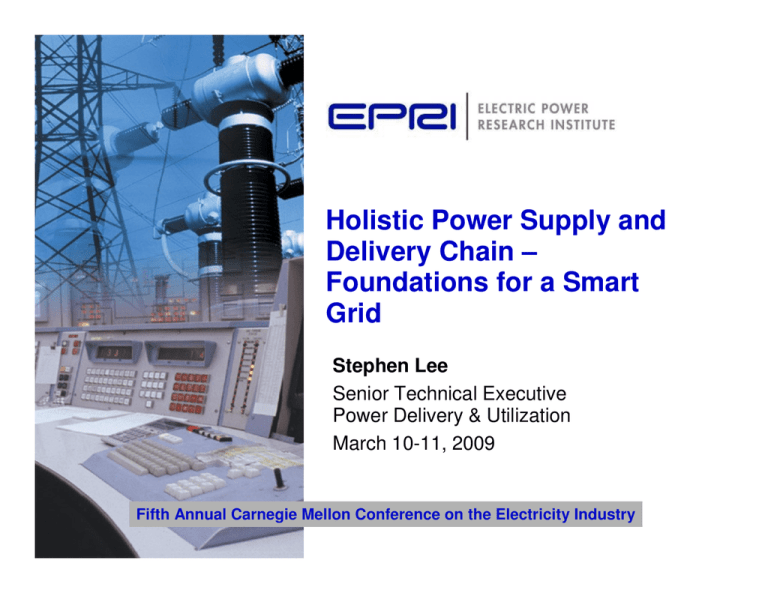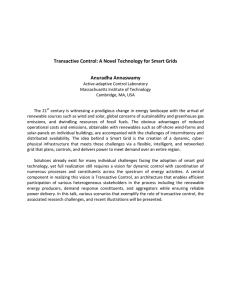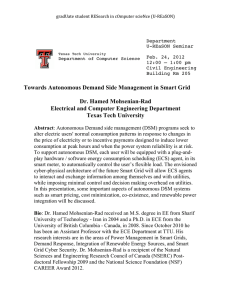Holistic Power Supply and Delivery Chain – Foundations for a Smart Grid
advertisement

Holistic Power Supply and Delivery Chain – Foundations for a Smart Grid Stephen Lee Senior Technical Executive Power Delivery & Utilization March 10-11, 2009 Fifth Annual Carnegie Mellon Conference on the Electricity Industry EPRI Report in Publication • Presented and used in Brainstorming session in support of NASPI (North America Synchro-Phasor Initiative) • Hosted by EPRI • Charlotte • October, 2008 • Major Building Blocks to turn the Smart Grid from Hype to Reality © 2008 Electric Power Research Institute, Inc. All rights reserved. 2 Smart Grid: Hype Cycle Smart Grid Need an Objective Assessment of the Potential for Smart Transmission and the Path to Achieve it © 2008 Electric Power Research Institute, Inc. All rights reserved. 3 Current State – System Operations 12 1 4 13 6 Limited Grid Visibility 14 5 2 15 7 8 17 16 9 3 11 10 2-4 Sec scan rates Limited to info from lines and transformers at substations Credit to • Paul Myrda for animation of the dots • Steve Lee for the cloud © 2008 Electric Power Research Institute, Inc. All rights reserved. MW, MVAR, KV breaker status 4 Smart Transmission State – System Operations 1 12 4 Enhanced Grid Visibility 750 +282j 440 + 200j 750 + 262j 13 6 14 5 2 300 + 100j 250 +84j 15 176 +88j 7 8 17 100 +62j 16 130 + 8j 120 + 11j 20 + 8j 9 3 276 + 120j 350 + 150j 11 10 227 + 420j Higher speed scan rates 704 + 308j Allows more frequent analysis of system state Credit to Paul Myrda for animation of the dots © 2008 Electric Power Research Institute, Inc. All rights reserved. 5 EPRI’s End-to-End Power Delivery Chain Operation & Planning Power Plants Transmission System Fuel Supply System Distribution System Renewable Plants Fuel Source/Storage Energy Storage End-uses & DR Controllers Sensors Data Data Communication Communication Wide Wide Area Area Control Control Dynamic Power Plant Models M ZIP Dynamic Load Models Monitoring, Monitoring, Modeling, Modeling, Analysis, Analysis, Coordination Coordination & & Control Control © 2008 Electric Power Research Institute, Inc. All rights reserved. 6 New Challenges for a Smart Grid • Need to integrate: – large-scale stochastic renewable generation – electric energy storage – distributed generation – plug-in hybrid electric vehicles – demand response (smart meters) • Need to deploy and integrate: – Synchronized measurement technologies – Sensors – System Integrity Protection Schemes (SIPS) © 2008 Electric Power Research Institute, Inc. All rights reserved. 7 Foundations Still Deficient • End-to-End Situational Awareness • Alarm Management and Root-Cause Diagnosis • Dynamic Models of all Generators and Loads • Faster System Restoration • System Integrity Protection Schemes – Faster reflex actions on wide-area problems – Measurement-based safety nets to prevent cascading blackouts, e.g., load shedding, islanding/separation, damping © 2008 Electric Power Research Institute, Inc. All rights reserved. 8 Alarm Management and Real-time Root-Cause Diagnosis Alarm Management • Need to diagnose root-cause of alarm messages • Need to link diagnosis to operator procedure • Current EMS alarm management uses technologies of the 1970s • Need to integrate all sources of data and messages, through a hierarchical approach © 2008 Electric Power Research Institute, Inc. All rights reserved. 9 Why Accurate Load and Generator Models Are Needed? Hassayampa 500 kV • Inadequacy of current model data – Inaccurate voltage recovery simulation after disturbances – Uncertainty about generator reactive power capabilities • Implications – Uncertainty about the stability margin of the power grid – Unaware of real risk of cascading blackouts or voltage collapse, or – Under utilization of available stability margin for greater economic benefits 1 Voltage (pu) 0.8 0.6 Measured Simulated Simulated Simulated Simulated Simulated Simulated 0.4 0.2 0 0 0.2 0.4 0.6 0.8 1 1.2 Time (seconds) 1.4 1.6 Southern Co.’s GenVARRTM © 2008 Electric Power Research Institute, Inc. All rights reserved. 10 H=0.3 H=0.03 H=0.05 H=0.1 H=0.2 H =0.5 1.8 2 Effective System Restoration Can Reduce The Societal Impact Of Widespread Blackouts Major Power System Disturbances 70 1 - 2003 NE 60 Restoration Objectives: Minimize Duration of Outages Minimized Unserved Loads Avoid Equipment Danage Load Lost in GW 50 40 30 6 - 1996 W SCC 20 2 - 1965 NE 4 - 1982 W SCC 10 5 - 1996 W SCC 3 - 1977 NYC 7 - 1998 MW 0 0 10 20 30 40 50 60 Duration in Hours Source: Mike Adibi, NSF/EPRI Workshop on Understanding and Preventing Cascading Failures in Power Systems, Oct 28, 2005. © 2008 Electric Power Research Institute, Inc. All rights reserved. 11 New Solutions Are Needed • Virtual Service Aggregators serving as Energy Balancing Authorities – Dispatch and control stochastic renewable generation – Dispatch and control (and own?) large scale energy storage plants – Manage demand response proactively – Manage smart electric vehicle charging • Optimal end-to-end commitment and dispatch by ISO/RTO as backstop for system reliability • CO2 Cap-and-Trade Market Monitoring © 2008 Electric Power Research Institute, Inc. All rights reserved. 12 Potential Role of the Virtual Service Aggregator Traditional Traditional Central CentralStation Station Power Plants Power Plants Large-Scale Large-Scale Renewable Renewable Resources Resources Large-Scale Large-Scale Energy Energy Storage Storage Transmission Transmission Grid Grid Real RealRegional Regional Control ControlCenter Center Financial Settlement of Net Difference Virtual Virtual Service Service Aggregator Aggregator S © 2008 Electric Power Research Institute, Inc. All rights reserved. 13 Loads Loads End Uses End Uses and and Distributed Distributed Resources Resources Distributed Distributed Generation Generation &&Storage Storage Power Flow Financial Transaction PHEVs PHEVs Conclusions • Urgent Need to Make the Bulk Power System Really Smart • Failure to Make this a High Priority would Jeopardize the Modernization of the Electric Power System • Strengthening the Foundations is Indispensable • Introducing New Solutions is critically needed © 2008 Electric Power Research Institute, Inc. All rights reserved. 14 Discussions © 2008 Electric Power Research Institute, Inc. All rights reserved. 15


